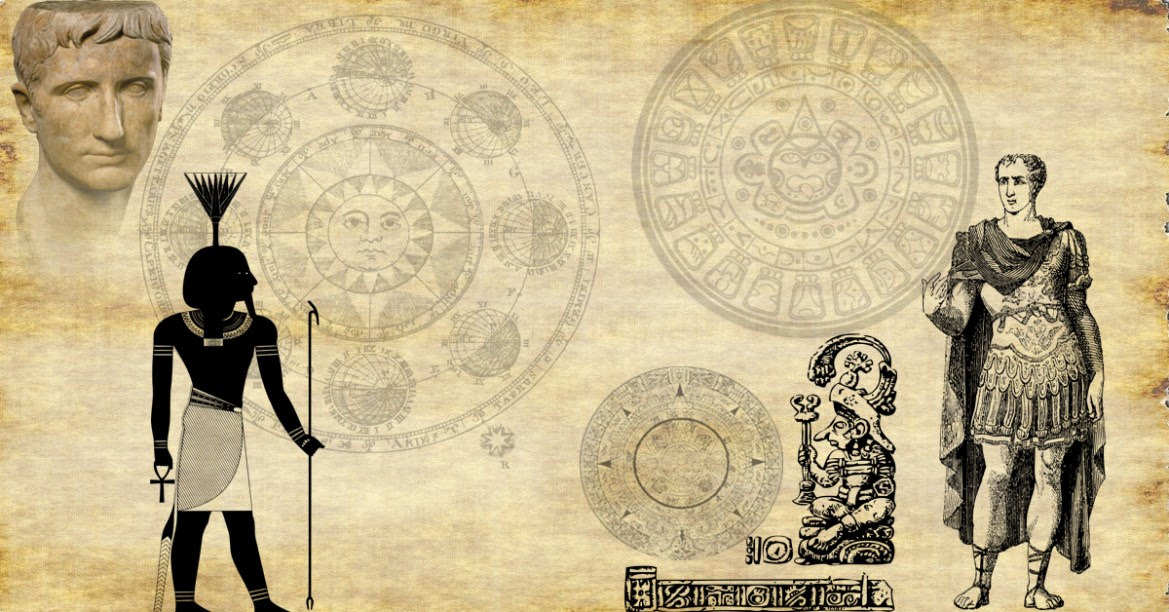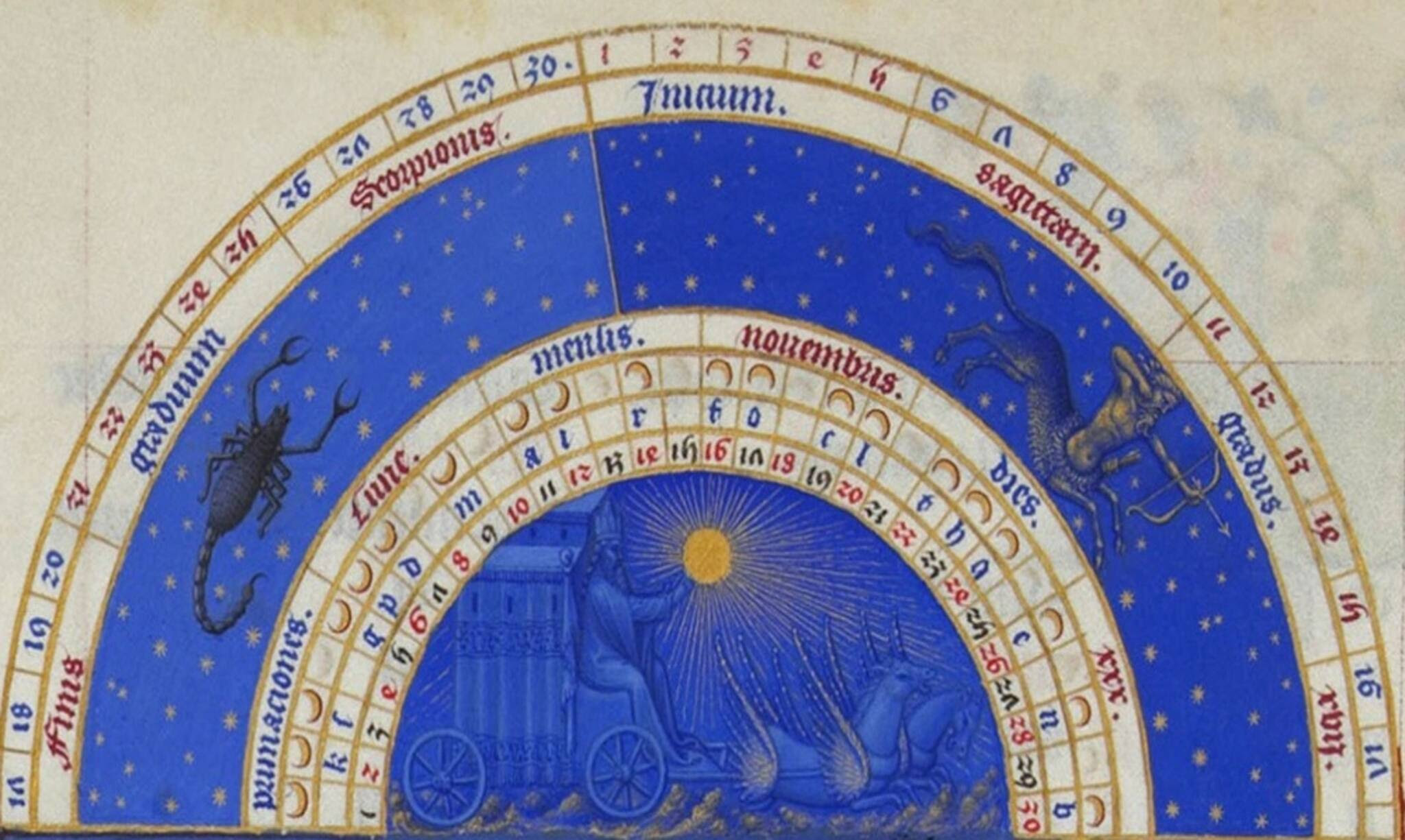The use of a calendar allowed us to fix the time by respecting astronomical, social, economic and religious constraints. Calendars use concepts as complex as mathematical calculations, units of measurement, lunar, solar, lunisolar and civil cycles. The word calendar comes from the Latin word calendar which corresponds to the word calendar, the first day of each month when debtors paid interest on their debt.
The calendar was designed to logically list the days, weeks, months and years, keeping in line with observable astronomical phenomena, such as the positioning of the Sun or Moon in space. The calendar we use, the Gregorian calendar, allows us to determine an average calendar year and the seasons. It is a solar calendar, based on the tropical year which corresponds to the time between two passages of the Sun at the equinox. The four most known calendars are :
The lunisolar calendar: calendar used in the Middle East, especially by the Mesopotamian and Babylonian civilizations. The months are referenced to the Moon and the years to the Sun. It is said to have originated in Mesopotamia around the 3rd millennium BC and is divided into two, three or four seasons depending on the region where it is used.
The Egyptian calendar: was originally based on the Moon but the Egyptians also used the seasonal character of the star Sirius, corresponding to a solar year. The Egyptians invented the 365-day calendar year divided into three seasons of four 30-day months and made the day begin at sunrise.
The Julian calendar: calendar introduced by Julius Caesar in 45 BC and used until 1582. It consists of three years of 365 days followed by a leap year which is added on February 29. The Julian calendar replaced the Roman republican calendar used before this date and which corresponded to a lunar calendar of 10 days shorter than the 365 days of the tropical year. In the Republican calendar, a thirteenth month was inserted every two years from February 23 or 24.
The Gregorian calendar: calendar established by Pope Gregory XIII in 1582 and used since that date. It replaced the Julian calendar, it includes a leap day every four years on February 29 and consists of 11 months of 30 or 31 days and one month of 28 or 29 days. The basis of the calendar is the Christian era which refers to the years as being before or after Jesus Christ. Since the creation of the Anno Domini in the 6th century, the year of Christ’s birth corresponds to year 1 and all world organizations have adopted this dating.
The division of time in the calendar The basic unit of a calendar is the day. For a long time and in some civilizations the day started at noon before the general use observed nowadays makes it start at midnight. Most primitive civilizations counted the days from dawn to dawn, adding the dawns to name the succession of days.
The Mesopotamians, Jews and Greeks counted the days from sunset to sunset, the Hindus and Egyptians counted the day from dawn to midnight, and the Romans counted the day from midnight to midnight. The oldest astronomical texts date back to the Babylonian period, but some principles could date back to the Sumerian period, around the 4th millennium BC. The hours could be of a different length depending on the season and be longer in summer than in winter.
From ancient times the seasonal difference corresponded to the duration of the Sun’s time above the horizon, taking into account its maximum in summer and its minimum in winter. This practice stopped with the arrival of mechanical clocks in Europe at the end of the 18th century.
The Greeks, Sumerians, Babylonians, Egyptians and Romans, then the Western culture, adopted the division of a day into twenty-four hours, twelve hours of daylight and twelve hours of darkness. But for daily worship, the Church adopted its own canonical hours, matins, prime, tierce, none, vespers and compline.
When it was necessary to define an intermediate period between the month and I days, many people seem to have taken into account the days of markets. This period could go from four days in Africa for example to ten days among the Egyptians, and the days of markets were held in intervals of eight days in ancient Rome.
The origin of the seven-day week can be traced back to the four seven-day phases of the moon and the sacredness of the number seven among the Sumerians, in reference to the seven planets of the solar system. The month is based on the lunation, the period during which the Moon completes a full cycle of its phases and which lasts approximately twenty-nine and a half days. This duration corresponds to the natural biological cycle of humans and animals and is close to the average menstrual period of women for example.
Most calendars have been formed by juxtapositions of months. The Sumerians alternated between twenty-nine and thirty days, the Egyptians between thirty and twenty-eight days, and the Greeks and Romans between thirty and thirty-one days. On the other hand, the seasons do not depend on observations linked to the cycle of the Moon but to that of the Sun, all observations leading to consider a year equal to 365 days. For the Greeks and civilizations further north, for example, a year quickly became a succession of four seasons.
The measurement of different periods of time: the length of the day can be measured by the stars or the Sun. The measurement with the stars corresponds to the sidereal day and is defined as the period between two passages of a star on a meridian of reference. The duration of the sidereal day is 23 hours 40 minutes and 4.10 seconds of a mean solar day.
The measurement of the day with the Sun corresponds to the interval between two passages of the Sun on the same meridian but the calculation is distorted because of the movement of the sun that changes with the seasons. In order to get rid of this constraint, an artificial Sun moving at a constant speed was created for the calculation of the average solar day.
This solar day has a duration of 24 hours 3 minutes and 56.55 seconds, less than the sidereal day because the Earth in its orbit must complete a little more than one revolution to bring the Sun back to the meridian of departure. The month is determined by the passage of the Moon around the Earth, either by calculating the time taken by the Moon to complete an orbit around the Earth or by calculating the time taken by the Moon to complete a full cycle of its phases.
This interval is called the synodic month, it is 29.53059 days and is used as a basis for the calendar month. The year is the time taken by the Earth to complete an orbit around the Sun and is calculated from the tropical year which corresponds to the apparent movement of the Sun. The tropical year is the interval between two successive passages of the Sun when it crosses the celestial equator around March 21, the point of the crossing being called the vernal point.
The duration of the tropical year is 365.242199 mean solar days. The tropical year and the synodic month could not be compatible, the twelve synodic months being shorter than the tropical year by about eleven days, scientists have resorted to the principle of intercalation, consisting of intercalating complimentary days in the calendars. In order to keep dates in harmony with the seasons, the solar calendar was preferred to the lunar calendar, but the difference between the months and the phases of the Moon increased.
Astronomical observations became essential to find the precise duration of the tropical year. As the stars are not visible at the same time as the Sun, it was necessary to determine the constellations between which the Sun moves during the year. This mechanism called a heliacal survey, is done by observing the stars that rise in the east at sunset to deduce the position of other stars. But these surveys to define the seasons of the tropical year were only possible in the tropics.
They were replaced in other regions by human buildings serving as landmarks along the horizon, such as Stonehenge in England for example. It is necessary to wait for the Roman periods so that a leap day is systematically set up every four years to make correspond the solar calendar with the agricultural seasons.
The creation of a single harmonized calendar: with the heliacal rises made from the star Sirius, the Egyptians had spotted that cycles were repeated, such as the difference of one day which returned every four tropical years. The Greco-Roman world mainly used until the 4th century BC cycle of eight years, the octoeterid, to get as close as possible to a harmonization.
Around 432 BC, the Athenian astronomer Meton proposed an equivalence cycle between the lunar cycle and the tropical year by observing the solstices to calculate the tropical year. He calculated a cycle of 19 years so that the difference between the solar and lunar calendars was only five days over the whole cycle.
The cycle of Meton was improved around 370 BC by the Greek astronomer Calippus who created the Callippic period, a cycle of four Meton periods. Around 150 BC, another Greek astronomer, Hipparchus, further improved the equivalence between the two calendars by discovering that the equinoxes, when the ecliptic crosses the celestial equator, are not fixed in space but have moved slightly westward. He was able to measure more precisely the length of the tropical year and then calculate the number of days of a lunation, which almost corresponds to that used today.
In order to chronologically date historical events as accurately as possible, the Frenchman Joseph-Juste Scaliger proposed in the 16th-century numbering of days corresponding to a cyclic period of great length. This system called the Julian period, is a cycle of 7,980 years, based on the Meton cycle, a solar cycle and a fiscal cycle introduced in Egypt by the Romans, called the indiction cycle. According to his calculations, the first Julian period began on January 1, 4713 BC and will end on January 23, 3268 of the Gregorian calendar. The principles of dating the Julian period are still used to date astronomical events, in computer software or by some organizations such as NASA for example, because the Julian period allows to get rid of the calendar adaptations related to leap years or months of unequal length.




Comment here